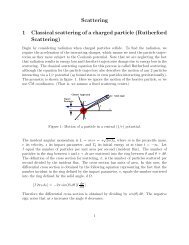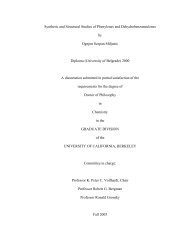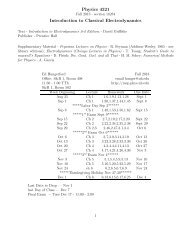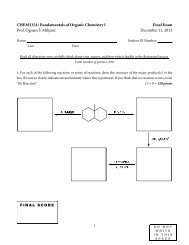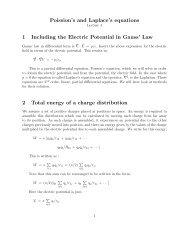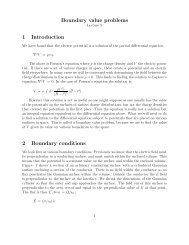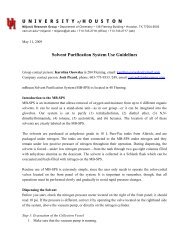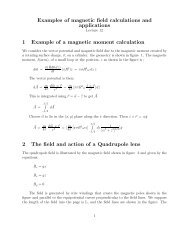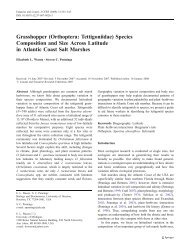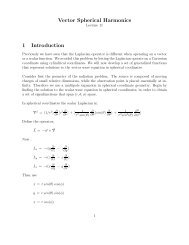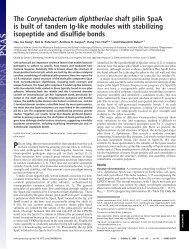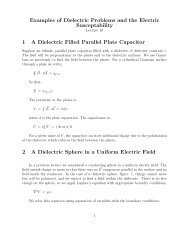Life Cycle and Growth of Senita Moths (Lepidoptera ... - BioOne
Life Cycle and Growth of Senita Moths (Lepidoptera ... - BioOne
Life Cycle and Growth of Senita Moths (Lepidoptera ... - BioOne
You also want an ePaper? Increase the reach of your titles
YUMPU automatically turns print PDFs into web optimized ePapers that Google loves.
ECOLOGY AND POPULATION BIOLOGY<strong>Life</strong> <strong>Cycle</strong> <strong>and</strong> <strong>Growth</strong> <strong>of</strong> <strong>Senita</strong> <strong>Moths</strong> (<strong>Lepidoptera</strong>: Pyralidae):A <strong>Lepidoptera</strong>n with Less Than Four Instars?J. NATHANIEL HOLLANDDepartment <strong>of</strong> Ecology <strong>and</strong> Evolutionary Biology,University <strong>of</strong> Arizona,Tucson,AZ 85721Ann. Entomol. Soc. Am. 96(4): 519Ð523 (2003)ABSTRACT Despite great variation in instar number among Insecta,no <strong>Lepidoptera</strong>n has beenobserved to have less than four larval instars. I report in this work on the life cycle <strong>and</strong> growth <strong>of</strong> thesenita moth, Upiga virescens Hulst,which forms an obligate pollinating predispersal seed-eatingmutualism with senita cacti (Lophocereus schottii Engelmann) in the Sonoran Desert <strong>of</strong> NorthAmerica. From 1996 to 1999,I studied larval growth <strong>and</strong> life cycle associations <strong>of</strong> U. virescens withL. schottii in the Þeld by labeling cohorts <strong>of</strong> eggs laid in ßowers <strong>and</strong> following them through pupation.All life stages <strong>of</strong> U. virescens were associated with ßowers,fruit,or cactus stems <strong>of</strong> L. schottii. Amongthe Þve cohorts studied,larval growth consistently conformed to DyarÕs rule. Only three larval instarswere identiÞed among the 500 larvae for which head capsule widths were measured. I discuss <strong>and</strong>dismiss the feasibility <strong>of</strong> a fourth undetected instar. I then discuss selection pressures that may havecontributed to the evolutionary loss <strong>of</strong> an instar,including a time <strong>and</strong>/or size constraint on larvalgrowth,as well as the nutritional quantity <strong>and</strong> quality <strong>of</strong> larval food.KEY WORDSDyarÕs rule,life history,plant-insect interaction,Upiga virescensLIFE CYCLES OF INSECTS vary greatly among ametabolous,hemimetabolous,<strong>and</strong>holometabolous species.Accompanied with this diversity in life cycles is greatvariation in the number <strong>of</strong> molts or instars within <strong>and</strong>among species. Ametabolous insects can molt 10,20,<strong>and</strong> even up to 60 times before reaching sexual maturity,whilehemimetabolous species most commonlyhave 4Ð6 nymphal molts before the adult stage. Holometabolousinsects can have as few as 2 instars or asmany as 20. IntraspeciÞc variation in the number <strong>of</strong>molts <strong>and</strong> instars results from differences in food quality<strong>and</strong> quantity,wounding <strong>of</strong> larvae,temperature,<strong>and</strong>,among others,photoperiod (Philogene <strong>and</strong> Benjamin1971,Wigglesworth 1972,Nijhout 1975,Barbosa<strong>and</strong> Capinera 1977,Taylor 1984,Bellinger <strong>and</strong> Pienkowski1987,Fantinou et al. 1996). Despite such variationin life cycles <strong>and</strong> number <strong>of</strong> molts,no moth orbutterßy has been observed to have less than fourinstars. In this study,I report data that indicate onlythree larval instars in a <strong>Lepidoptera</strong>n. SpeciÞcally,Istudied the life cycle <strong>and</strong> growth <strong>of</strong> the senita moth,Upiga virescens Hulst,which forms a pollinating predispersalseed-eating mutualism with senita cacti(Lophocereus schottii Engelmann). Both senita moths<strong>and</strong> senita cacti are endemic to the Sonoran Desert <strong>of</strong>northwestern Mexico <strong>and</strong> southern Arizona. Interactionsbetween senita cacti <strong>and</strong> senita moths are mostecologically <strong>and</strong> evolutionarily similar to those betweenyucca <strong>and</strong> yucca moths (Pellmyr et al. 1996,Fleming <strong>and</strong> Holl<strong>and</strong> 1998). <strong>Senita</strong> cactus reproductionis dependent on senita moth pollination,<strong>and</strong> thegrowth <strong>of</strong> larvae emerging from eggs laid in ßowers isobligately dependent on fruit resources resulting frommoth pollination (Holl<strong>and</strong> <strong>and</strong> Fleming 1999).Materials <strong>and</strong> MethodsData were collected near Bahia de Kino,Sonora,Mexico (29 N,110 W),from 1996 to 1999. The senitamoth, U. virescens, is a pyralid moth with forewings7Ð10 mm in length. U. virescens is in the subfamilyGlaphyriinae <strong>and</strong> is the only species in its genus. Untilrecently (Holl<strong>and</strong> <strong>and</strong> Fleming 1999),the only report<strong>of</strong> U. virescens was its species account (Munroe 1972).I studied the life cycle <strong>and</strong> growth <strong>of</strong> U. virescens byfollowing cohorts from eggs to pupae. Because mothstypically lay one egg per ßower (Holl<strong>and</strong> <strong>and</strong> Fleming1999),I was able to study individual eggs by taggingindividual ßowers. I labeled one cohort <strong>of</strong> eggs in 1996(n 586 eggs) <strong>and</strong> four cohorts in 1998 (n 140,634,612,<strong>and</strong> 252 eggs). Every 1Ð2 d during development<strong>of</strong> eggs to adults,I destructively sampled a r<strong>and</strong>omsubset (12Ð72) <strong>of</strong> individuals in each cohort by collectingßowers,immature fruit,or areoles (spine-bearingpads that produce ßowers). For each sample,Idissected the corolla,immature fruit,<strong>and</strong>/or areole toidentify life stage associations <strong>of</strong> U. virescens with thesenita cactus <strong>and</strong> to collect preadult life stages. Samples<strong>of</strong> U. virescens were preserved in 70% ethanol. Todetermine whether the Þrst instar observed in the Þeldwas the same as that emerging from eggs,fresh eggswere collected in 1998 (n 102) <strong>and</strong> 1999 (n 133).0013-8746/03/0519Ð0523$04.00/0 2003 Entomological Society <strong>of</strong> America
520 ANNALS OF THE ENTOMOLOGICAL SOCIETY OF AMERICA Vol. 96,no. 4Each egg was placed in a pill capsule to collect emerginglarvae. I measured head capsule widths (HCWs)<strong>of</strong> intact larvae <strong>of</strong> preserved specimens for the 1996cohort (n 82 larvae) <strong>and</strong> the four cohorts <strong>of</strong> 1998(n 48,197,53,<strong>and</strong> 18 larvae),using a dissectingmicroscope with an ocular micrometer calibrated witha stage micrometer.ResultsNumber <strong>of</strong> Larval Instars. The frequencies <strong>of</strong>HCWs measured from larvae collected in 1996 wereclustered into three distinct size classes,suggestingthree larval instars (Figs. 1A <strong>and</strong> 2). In 1998,I collectedlarvae from an additional four cohorts. Frequencies <strong>of</strong>HCWs <strong>of</strong> those cohorts also clustered into three distinctsize classes (Figs. 1BÐD <strong>and</strong> 2). Hereafter,I referto these size classes <strong>of</strong> HCWs as instar 1 (mean 1 SE;0.428 0.011 mm),instar 2 (0.637 0.005 mm),<strong>and</strong>instar 3 (1.04 0.011 mm). Notably,little variationoccurred in HCWs for the three instars within oramong cohorts (Fig. 2). The coefÞcients <strong>of</strong> variationamong the Þve cohorts for the three instars were 5.5,1.7,<strong>and</strong> 2.4%,respectively.DyarÕs rule (Dyar 1890) states that larval growthprogresses geometrically <strong>and</strong> by a relatively constantfactor. DyarÕs rule predicts that a linear measure <strong>of</strong> sizeincreases by a constant factor from one instar to thenext. This growth factor is calculated by dividing thelinear measure <strong>of</strong> size for one instar by that measure<strong>of</strong> size for the previous instar. This produces a growthratio for each larval molt. When insect growth followsDyarÕs rule (which it <strong>of</strong>ten does not [e.g.,Goettel <strong>and</strong>Philogene 1979,Jobin et al. 1992]),growth ratios arecommonly 1.4. According to DyarÕs rule,a stronglinear relationship is predicted between the log <strong>of</strong> alinear measurement <strong>of</strong> size <strong>and</strong> instar number. Figure3 shows this relationship for each <strong>of</strong> the Þve cohorts<strong>of</strong> U. virescens. In all Þve cases,there was a stronglinear relationship between log HCW <strong>and</strong> instar number(Fig. 3). For each <strong>of</strong> the Þve cohorts,the linearregression line captured 99Ð100% <strong>of</strong> variation inHCW. Moreover,slopes <strong>of</strong> these regression lines variedlittle among cohorts (Fig. 3),indicating similarincrements in larval growth among cohorts. Theseanalyses suggest that larval growth <strong>of</strong> U. virescens doesfollow a geometric pattern consistent with DyarÕs rule(Figs. 2 <strong>and</strong> 3). However,the mean (1 SE) growthratio <strong>of</strong> the Þve cohorts from instar 1Ð2 was 1.49(0.019) <strong>and</strong> from instar 2Ð3 was 1.63 (0.008). Theseaverage growth ratios do not deviate greatly from the1.4 generally observed for insects,but they are statisticallydifferent from one another (t 4.36,df 8, P 0.05). Hence,while larvae <strong>of</strong> U. virescens do growgeometrically (Fig. 2) <strong>and</strong> by a constant factor (Fig.3),there is slight,but signiÞcantly greater growth fromthe second to third instar than from the Þrst to second.Association <strong>of</strong> <strong>Life</strong> Stages with <strong>Senita</strong> Cactus. Femalesenita moths invariably lay their eggs in openßowers <strong>of</strong> senita cacti,which open at sunset <strong>and</strong> closewithin 8Ð12 h. The chorion presumably has a substanceon it for adhesion to ßowers; eggs are not easilyblown or knocked <strong>of</strong>f ßowers. Larvae can hatch withinhours after the egg is laid,but may take up to 3 d. Offreshly laid eggs collected from ßowers in 1998 (n 102) <strong>and</strong> 1999 (n 133),100 <strong>and</strong> 92% were viable,respectively,producing Þrst instars. Only 3% <strong>of</strong> collectedeggs showed any sign <strong>of</strong> a larva having eaten thechorion,<strong>and</strong> even then,nearly all <strong>of</strong> the chorion remaineduneaten. These larvae had a mean (1 SE)HCW <strong>of</strong> 0.43 mm (0.003),which was not differentfrom Þrst instars collected from cohorts studied in1996 <strong>and</strong> 1998 (0.43 0.002; n 166 larvae).Larvae <strong>of</strong> U. virescens are eruciform. The Þrst stadiumcan last up to 7 d,but typically is 4 d long (Fig. 4).First instar larvae move down wilting corollas <strong>of</strong> ßowerstoward developing ovules <strong>and</strong> immature fruit. Larvaetypically do not feed until they reach the bottom<strong>of</strong> the corolla <strong>and</strong> the top <strong>of</strong> the developing fruit.Ecdysis,<strong>and</strong> the appearance <strong>of</strong> the second instar,isassociated with consumption <strong>of</strong> tissue as larvae boreinto developing fruit. However,if a larva does notreach the bottom <strong>of</strong> the corolla <strong>and</strong> the top <strong>of</strong> thedeveloping fruit within 5Ð6 d,tissue at the corolla-fruitinterface becomes too hard for a larva to bore into it.Dead Þrst instars are commonly found at the base <strong>of</strong>the corolla after days 5Ð6 (Holl<strong>and</strong> <strong>and</strong> Fleming 1999).Second instars feed within the immature fruit ondeveloping ovules <strong>and</strong> fruit tissue. The second molt,<strong>and</strong> emergence <strong>of</strong> the third instar,occurs within thefruit,usually at8d<strong>of</strong>age(Fig. 4). There is never morethan one larva per fruit,<strong>and</strong> a larva rarely consumes50% <strong>of</strong> developing ovules (Holl<strong>and</strong> <strong>and</strong> Fleming1999). As second <strong>and</strong> third instars feed,they worktheir way from the top <strong>of</strong> the immature fruit towardthe bottom,where the fruit is attached to the areole<strong>of</strong> the cactus stem. Usually at 12 d <strong>of</strong> age,but occasionallyas late as 17 d,third instars bore a hole out <strong>of</strong>the base <strong>of</strong> fruit where the fruit is attached to theareole,through the areole,<strong>and</strong> into the cactus stem.This invariably induces those fruit to abscise <strong>and</strong> fall<strong>of</strong>f cacti. A larva then creates a small gallery within thecactus stem by consuming stem tissue. Larval feedinghas not been observed after the creation <strong>of</strong> galleries incactus stems. Third instars either enter into the pupalstage,in which case they emerge as adults from thecactus stem within the same ßowering season,or theydiapause as prepupal third instars <strong>and</strong> emerge as adultsduring a subsequent ßowering season. Pupae are obtect<strong>and</strong> can occur as early as 17 d <strong>of</strong> age. <strong>Moths</strong> exitgalleries through the holes made by larvae boring intothe cactus stem. Bodies harden <strong>and</strong> wings Þll withhemolymph as moths sit on spines <strong>of</strong> cacti. Mating alsotakes place on spines.DiscussionHead capsule widths <strong>of</strong> the 504 larvae measured inthis study clustered into three distinct size classes(Figs. 1Ð4),indicating that U. virescens breaks,ratherthan conforms,to the general rule <strong>of</strong> no less than fourlarval instars in <strong>Lepidoptera</strong>. This is the Þrst study,tomy knowledge,to show a lepidopteran with only threelarval instars. There are at least three places in the life
July 2003 HOLLAND: LIFE CYCLE AND GROWTH OF SENITA MOTHS 521Fig. 1. Frequency distribution <strong>of</strong> head capsule widths (mm) <strong>of</strong> U. virescens (Pyralidae) for a cohort in 1996 (A); cohorts1 (B),2 (C),<strong>and</strong> 3 (D) in 1998; Þrst instar larvae emerging from eggs (E); <strong>and</strong> all head capsule widths from the cohort in1996,the four cohorts in 1998,<strong>and</strong> larvae emerging from eggs. A separate Þgure for head capsule widths for cohort 4 <strong>of</strong> 1998is not included because <strong>of</strong> small sample size. The relative frequency <strong>of</strong> different size classes is an artifact <strong>of</strong> sample size,notthe relative abundance <strong>of</strong> individuals within size classes.
522 ANNALS OF THE ENTOMOLOGICAL SOCIETY OF AMERICA Vol. 96,no. 4Fig. 4. Proportion <strong>of</strong> U. virescens larvae in each <strong>of</strong> threeinstars as a function <strong>of</strong> larval age (days).Fig. 2. Average (1 SE) head capsule widths (mm) <strong>of</strong>U. virescens for each <strong>of</strong> three discrete size classes,identiÞedas instar 1,2,<strong>and</strong> 3. Data are presented for each <strong>of</strong> the Þvecohorts studied <strong>and</strong> the mean <strong>of</strong> these Þve cohorts.cycle <strong>of</strong> U. virescens in which an additional instar mayhave occurred,but was undetected: 1) between instars1 <strong>and</strong> 3; 2) before instar 1; <strong>and</strong> 3) after instar 3.If larval growth <strong>of</strong> U. virescens progresses geometrically<strong>and</strong> by a fairly constant factor,as suggested byDyarÕs rule,then I can deduce whether a size class <strong>of</strong>HCWs is missing between instars 1 <strong>and</strong> 2 or 2 <strong>and</strong> 3based on predicted changes in HCWs. The average(1 SE) growth ratio empirically observed forU. virescens was 1.56 (0.03; n 10). Based on anHCW <strong>of</strong> 0.428 mm observed for instar 1,the predictedHCW for instars 2 <strong>and</strong> 3 are 0.668 <strong>and</strong> 1.042 mm,respectively. These predictions deviate little fromobserved values for instars 2 (0.637 mm) <strong>and</strong> 3(1.042 mm). Hence,a size class <strong>of</strong> HCW representinganother instar cannot occur between what I haveidentiÞed as instars 1,2,<strong>and</strong> 3.Fig. 3. Log <strong>of</strong> head capsule width <strong>of</strong> U. virescens as afunction <strong>of</strong> instar number for the Þve cohorts studied. RegressioncoefÞcients <strong>and</strong> linear regression equations are inthe legend.Based on DyarÕs rule,if an instar occurs before0.43 mm HCW,then it is predicted to have an HCWranging from 0.263 to 0.306 mm,with an average <strong>of</strong>0.274 mm. No larva that I measured had an HCW 0.36mm. Yet,it remains possible that the sampling methodprecluded detection <strong>of</strong> such an instar all together. Forthis reason,I collected eggs to compare HCWs <strong>of</strong>emerging Þrst instar larvae (Fig. 1E) with HCWs <strong>of</strong>the smallest size class collected in the Þeld. The mean(1 SE) HCW <strong>of</strong> larvae (n 102) emerging from eggswas 0.43 mm 0.003. This HCW was not differentfrom the smallest size class <strong>of</strong> larva (0.43 mm 0.002;n 166 larvae) collected from the Þve cohorts in theÞeld. Hence,the instar emerging from eggs is what Ihave identiÞed as instar 1.Based on DyarÕs rule,if an instar occurs after whatI identiÞed as instar 3 (1.04 mm HCW),then it ispredicted to have an HCW ranging from 1.46 to1.70 mm,with an average 1.62 mm. No larva collectedhad an HCW 1.22 mm,which is substantially belowthat predicted for an additional instar. It is unlikelythat another undetected instar occurs after what Ihave identiÞed as instar 3 (HCW 1.04 mm). Recallfrom the life cycle <strong>of</strong> U. virescens that a larva bores ahole out <strong>of</strong> the immature fruit,through the areole,<strong>and</strong>into the cactus stem. Within the cactus stem,the larvaconsumes tissue creating a small gallery (1 cm 3 ).Stem tissue hardens <strong>and</strong> forms hard calluses whendamaged,such as occurs with other columnar cacti(e.g., “boots” <strong>of</strong> saguaro, Carnegiea gigantea Engelmann).These hard calluses prohibit further feedingby larvae. I dissected 1000 areoles <strong>and</strong> galleriesover 8 yr,but never observed an HCW 1.22 mm. Yet,within these galleries I have observed pupae,pupalcases,<strong>and</strong> emerging moths. Hence,the instar identi-Þed as instar 3 is the terminal prepupal instar.For holometabolous insects,it is not the number <strong>of</strong>instars that determines when metamorphosis occurs.Rather,a threshold size determines that a particularinstar is the last (Nijhout 1975),<strong>and</strong> within this lastinstar,a critical weight determines when metamorphosisoccurs (DÕAmico et al. 2001). The number <strong>of</strong>instars required to reach this critical weight can varywith the nutritional quality <strong>and</strong> quantity <strong>of</strong> food resources(Davidowitz et al. 2003). For example,indi-
July 2003 HOLLAND: LIFE CYCLE AND GROWTH OF SENITA MOTHS 523viduals feeding on a nutritionally poor food,such aslow-dietary nitrogen,may require more instars toreach their critical weight than individuals feeding ona more nitrogen-rich diet (Chapman 1982,Taylor1984,Nijhout 1994). Amino acids <strong>and</strong> proteins <strong>of</strong> developingseeds in senita cactus fruit provide a nutritionally-richdiet for moth larvae. Tissue <strong>of</strong> senitacactus stems has high concentrations <strong>of</strong> alkaloids. BecauseL. schottii is the only known host plant <strong>of</strong> U.virescens, it is not unreasonable to hypothesize thatlarvae can break down these alkaloids <strong>and</strong> possibly usethe nitrogen-rich by-products. Nutritional quality <strong>of</strong>fruit <strong>and</strong> stem tissue <strong>of</strong> L. schottii most likely has notinhibited the evolutionary loss <strong>of</strong> an instar. Moreover,the constancy in the quality <strong>and</strong> quantity <strong>of</strong> larval foodresources may explain why there is strikingly littlevariation in growth <strong>and</strong> size (HCW) <strong>of</strong> larvae withininstars <strong>and</strong> among cohorts (Fig. 2).Assuming that U. virescens can obtain sufÞcient nutritionalquality <strong>and</strong> quantity from senita cacti withinthree instars,there are at least three hypotheses <strong>of</strong>selection pressures for the evolutionary loss <strong>of</strong> aninstar. First,there may be a size constraint on larvae.If larvae continue to grow <strong>and</strong> molt after entering thecactus stem,adult moths could be too large to emergefrom the hole in the areole <strong>of</strong> the cactus stem made byan earlier instar with a small HCW. Second,there maybe a constraint on time in which larval developmentcan occur. Fruit can mature quickly,within 21 d,<strong>and</strong>seed coats can begin to harden as quickly as within16 d,making them unavailable as food for larvae.This short time for larvae to feed on fruit may explainwhy they only consume 50% <strong>of</strong> developing ovulesbefore boring into cactus stems (Holl<strong>and</strong> <strong>and</strong> Fleming1999). Finally,the loss <strong>of</strong> an instar would shorten thelife cycle <strong>of</strong> U. virescens <strong>and</strong> allow more generations toÞt within ßowering seasons <strong>of</strong> senita cacti. Thus,thedata presented in this study indicate that U. virescensis the Þrst <strong>Lepidoptera</strong>n documented to have onlythree larval instars. Both the nutritional quality <strong>of</strong>senita cacti <strong>and</strong> selection pressures on the evolution <strong>of</strong>its life cycle are consistent with a shortened developmentalperiod.AcknowledgmentsI thank the Mexican government for permission to conductresearch in Mexico. Thanks to A. K. Blanco Cisneros,M.Olivo Hern<strong>and</strong>ez,D. Kiley,J. Massoud,<strong>and</strong> H. Passmore forassistance in collecting larvae. I thank O. Pellmyr for Þrstpointing out to me that <strong>Lepidoptera</strong> are not known to haveless than four instars. I thank R. Chapman,G. Davidowitz,G.Gentry,D. Hahn,O. Pellmyr,<strong>and</strong> M. Singer for discussionson these data <strong>and</strong>/or commenting on a draft <strong>of</strong> this paper.Research was supported by National Science Foundation(NSF) DEB-9800775,National Geographic Society,<strong>and</strong> theNational Academy <strong>of</strong> Sciences <strong>and</strong> Sigma Xi fund. Preparation<strong>of</strong> this paper was made possible through the NationalParks Ecological Research Fellowship Program,a programfunded by the National Park Foundation through a generousgrant from the Andrew W. Mellon Foundation.References CitedBarbosa, P., <strong>and</strong> J. L. Capinera. 1977. The inßuence <strong>of</strong> foodon developmental characteristics <strong>of</strong> the gypsy moth, Lymantriadispar (L.). Can. J. Zool. 55: 1424Ð1429.Bellinger, R. G., <strong>and</strong> R. L. Pienkowski. 1987. Developmentalpolymorphism in the red-legged grasshopper, Melanoplusfemurrubrum (DeGeer) (Orthoptera: Acrididae).Environ. Entomol. 16: 120Ð125.Chapman, R. F. 1982. The insects: structure <strong>and</strong> function,3rd ed. Harvard University Press,Cambridge,MA.D’Amico, L. J., G. Davidowitz, <strong>and</strong> H. F. Nijhout. 2001. Thedevelopmental <strong>and</strong> physiological basis <strong>of</strong> body size evolutionin an insect. Proc. R. Soc. Lond. B. 268: 1589Ð1593.Davidowitz, G., L. J. D’Amico, <strong>and</strong> H. F. Nijhout. 2003. Therole <strong>of</strong> critical weight in the development <strong>of</strong> insect bodysize. Evol. Develop. (in press).Dyar, H. G. 1890. The number <strong>of</strong> moults <strong>of</strong> lepidopterouslarvae. Psyche 5: 420Ð422.Fantinou, A. A., J. A. Tsitsipis, <strong>and</strong> M. G. Kar<strong>and</strong>inos. 1996.Effects <strong>of</strong> short- <strong>and</strong> long-day photoperiods on growth<strong>and</strong> development <strong>of</strong> Sesamia nonagrioides (<strong>Lepidoptera</strong>:Noctuidae). Environ. Entomol. 25: 1337Ð1343.Fleming, T. H., <strong>and</strong> J. N. Holl<strong>and</strong>. 1998. The evolution <strong>of</strong>obligate pollination mutualisms: senita cactus <strong>and</strong> senitamoth. Oecologia 114: 368Ð375.Goettel, M. S., <strong>and</strong> B.J.R. Philogene. 1979. Further studieson the biology <strong>of</strong> Pyrrharctia (Isia) isabella (<strong>Lepidoptera</strong>:Arctiidae). III. The relation between head capsule width<strong>and</strong> number <strong>of</strong> instars. Can. Entomol. 111: 323Ð326.Holl<strong>and</strong>, J. N., <strong>and</strong> T. H. Fleming. 1999. Mutualistic interactionsbetween Upiga virescens (Pyralidae),a pollinatingseed-consumer,<strong>and</strong> Lophocereus schottii (Cactaceae).Ecology 80: 2074Ð2084.Jobin, L., C. Hebert, <strong>and</strong> J. P. Bourassa. 1992. Head capsulewidth <strong>of</strong> larval populations <strong>of</strong> the gypsy moth (<strong>Lepidoptera</strong>:Lymantriidae) in Quebec,with reference to DyarÕsHypothesis. Environ. Entomol. 21: 89Ð93.Munroe, E. 1972. The moths <strong>of</strong> America north <strong>of</strong> Mexico:Fascicle 13.1B,Pyraloidea (in part). E. W. Classey Ltd.<strong>and</strong> R.B.D. Publications Inc.,London,Engl<strong>and</strong>.Nijhout, H. F. 1975. A threshold size for metamorphosis inthe tobacco hornworm, M<strong>and</strong>uca sexta (L.). Biol. Bull.149: 214Ð225.Nijhout, H. F. 1994. Insect hormones. Princeton UniversityPress,Princeton,NJ.Pellmyr, O., J. N. Thompson, J. M. Brown, <strong>and</strong> R. G. Harrison.1996. Evolution <strong>of</strong> pollination <strong>and</strong> mutualism in theyucca moth lineage. Am. Nat. 148: 827Ð847.Philogene, B.J.R., <strong>and</strong> D. M. Benjamin. 1971. Temperature<strong>and</strong> photoperiod effects on the immature stages <strong>and</strong>adults <strong>of</strong> Neodiprion swainei (Hymenoptera: Diprionidae).Can. Entomol. 103: 1705Ð1715.Taylor, M.F.J. 1984. The dependence <strong>of</strong> development <strong>and</strong>fecundity <strong>of</strong> Samea multiplicalis on early larval nitrogenintake. J. Insect Physiol. 30: 779Ð785.Wigglesworth, V. B. 1972. The principals <strong>of</strong> insect physiology,7thed. Chapman & Hall,New York.Received for publication 28 March 2003; accepted 2 April2003.




